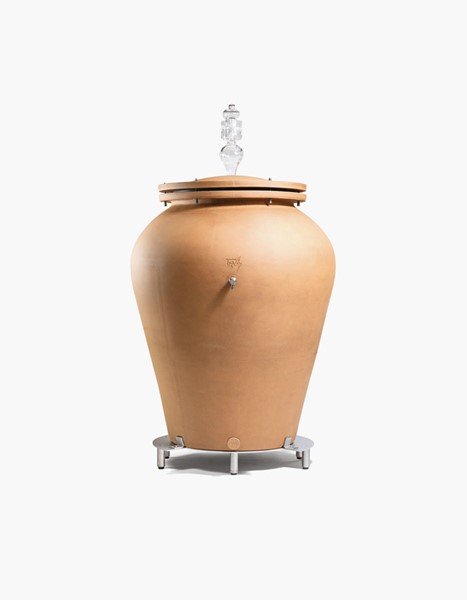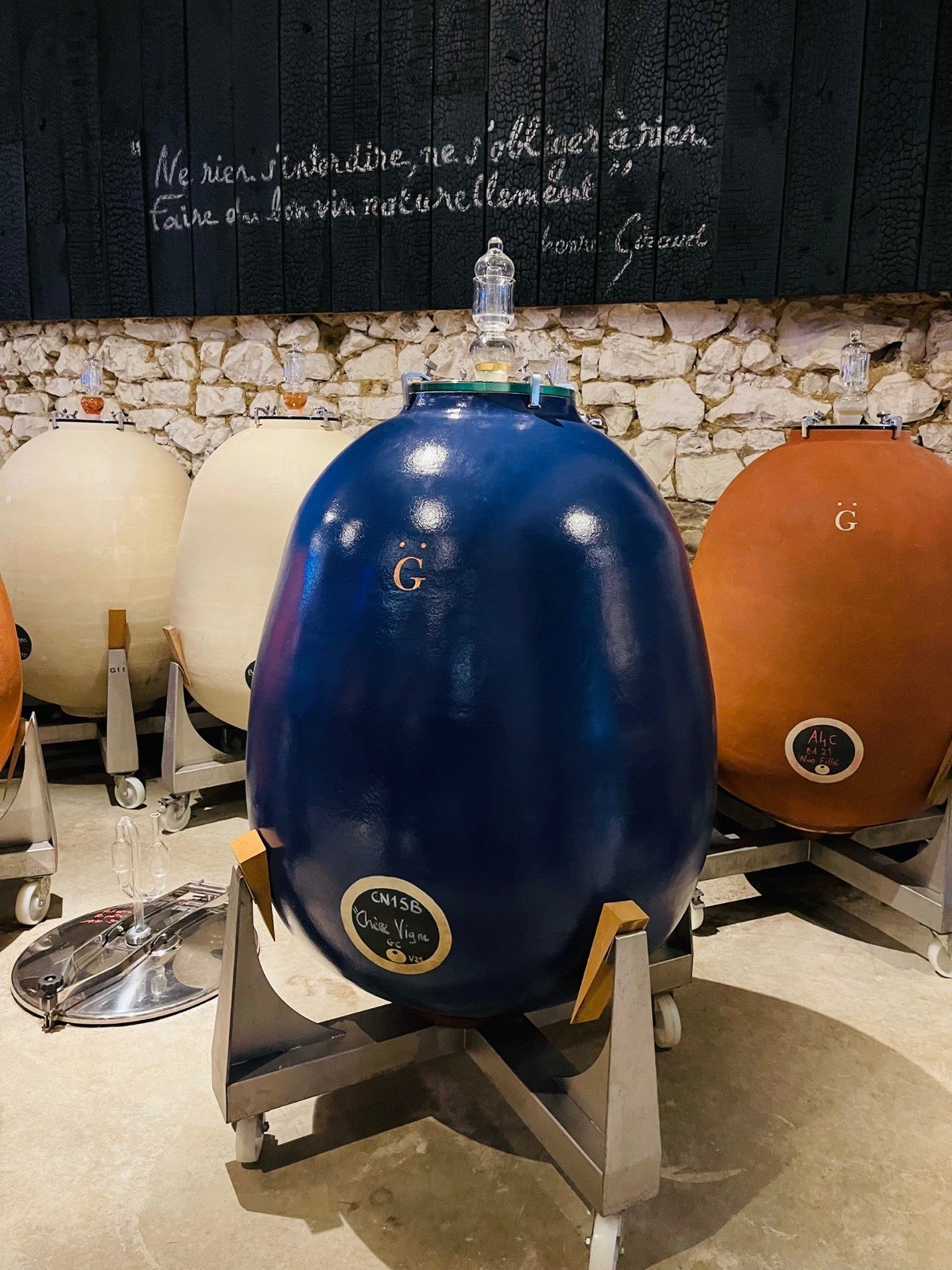The Loire Valley: An Amphora That Makes a Splash 盧瓦河谷: 大放異彩的陶罐
從2018年起法國掀起了一股泥陶罐復興熱潮,這是一種“返璞歸真”的創新。使用陶罐釀酒最早可以追溯到15世紀,這種帶有濃烈藝術色彩的容器隨後逐漸被水泥槽、橡木桶、不鏽鋼等不同的材質的容器慢慢地取代。盧瓦河谷在這一波新的陶罐復興的浪潮中無疑是法國走得最靠前的產區之一。陶罐在盧瓦河谷多樣性的產區優勢中似乎也找到了理想的宿主。
陶罐目前還不能全面取代橡木桶,它只能作為一個補充,但它獨特的優勢已經讓盧瓦谷的釀酒師們感到驚訝。陶罐目前按照燒製的溫度分為兩大類: 缸土/砂岩(Sandstone) 和陶瓦(terra-cotta)。陶瓦的燒製溫度為980-1050度,氣孔密度6%-10%;缸土/砂岩的陶罐燒製溫度約為1200-1350度,氣孔密度比陶瓦的更小。因此陶瓦適用於少數粗獷的紅葡萄酒, 缸土/砂岩則適用於白葡萄酒或單寧強的紅葡萄酒。使用缸土/砂岩陶罐最有代表性的酒莊為香檳酒莊Henri Giraud。今年3月拜訪酒莊的時候,酒莊釀酒總監還得意地向我展示了他們的陶罐系列。
減少SO2的使用
使用陶罐進行陳釀在葡萄酒裝瓶前只需要添加大約45mg/l SO2,這有助於保留更多的葡萄酒香氣。SO2的作用雖然無可替代,但對葡萄酒香氣的抑制是眾多釀酒師一直在尋求解決的問題,似乎陶罐在這一個領域上有著獨特的優勢。
陶瓷罐的微氧化效果更好
釀酒用陶罐的透氣孔比橡木桶更小。越小的氣孔代表著微氧化效果更好而且氧化風險會更低。因此單寧高的品種如 Malbec、Cabernet Franc和 Cabernet Sauvignon這些葡萄品種在陶罐中的試驗效果似乎更好,陳釀出來的葡萄酒帶有香氣純淨,新鮮感好,酒體圓潤,單寧細膩的特點。
維護更容易,成本效益更高
酒石酸結晶在不鏽鋼或橡木桶發酵罐中的清洗很困難,在陶罐中就容易得多。基本上用水一沖刷酒石酸結晶體就會自動脫落,而且用水量比清潔橡木桶少5倍。另外一個是價格優勢巨大,一個450L的橡木桶要€1200,一個陶罐要€3500,但橡木桶的使用年限比陶罐要短得多,而橡木桶的保養維護費更是陶罐的數倍,因此陶罐的總體成本更低。
除了大放異彩的陶罐,盧瓦谷近年還有一個酒莊廣受關注: Domaine de la Noblaie。 酒莊目前由Jérôme Billard和他的妻子共同負責管理。 Jérôme在勃根地完成了他的釀酒專業課程後,先後在波爾多頂級名家Petrus和美國Napa Valley的膜拜酒莊Dominus 工作,這些寶貴的工作經驗也讓Jérôme在眾多盧瓦谷的釀酒師中開始嶄露頭角成為最炙手可熱的年輕釀酒師之一。深受勃根地釀酒理念的啟發, Jérôme接管酒莊之後開展了一系列的葡萄園的微生態環境改善工程,一方面是為了照顧酒莊珍貴的老滕,最老的葡萄樹來自達到70年樹齡的Chenin Blanc;另一方面也深知只有健康可持續的葡萄園才能出產優質的葡萄,並協助酒莊在2014年取得了有機認證。
以50年樹齡的Chenin Blanc 釀造的Chante Le Vent從2019年開始使用陶罐和橡木桶的組合進行釀造和陳釀,陶罐獨有的優勢為這款葡萄酒賦予了更多的複雜性,這是一款不可錯過的Chenin Blanc。
旗艦酒款Pierre De Tuf是來自酒莊最頂級的燧石粘土地塊,平均樹齡達到70年。一個雕刻在15世紀的石灰岩上的酒桶賦予了這款葡萄酒迷人的香氣,複雜宏大的結構和驚人的陳年潛力。這是一款不能錯過的頂級盧瓦河谷Cabernet Franc。
有關Domaine de la Noblaie更詳盡的資訊,請瀏覽網站: https://www.vynluna.com/domaine-de-la-noblaie
Since 2018, France has been experiencing a renaissance in ceramic pots, a "back-to-basics" innovation. Dating back to the 15th century, concrete vats, oak barrels, stainless steel, and other materials have slowly replaced the use of ceramic pots for winemaking. The Loire Valley is undoubtedly one of the most advanced regions in France in this new wave of a ceramic renaissance. The ceramic pot has also found an ideal host in the diverse production area of the Loire Valley.
The ceramic pot has yet to become a complete replacement for the oak barrel, it can only be used as a supplement, but its unique advantages have already surprised the winemakers of the Loire Valley. The pots are divided into two categories according to the firing temperature: sandstone and terra-cotta. Terra-cotta tiles are fired at 980-1050 degrees and have a pore density of 6%-10%; While sandstone pots are fired at around 1200-1350 degrees and have a lower pore density than terra-cotta tiles. This is why terra-cotta is used for a few bold reds and sandstone for white wines or tannic reds. The most representative winery using sandstone pots is the Champagne house Henri Giraud, whose winemaking director was proud to show me their range of pots when I visited the house in March this year.
Reducing the dosage of SO2
The use of ceramic pots for ageing only requires the addition of around 45mg/l SO2 before bottling, which helps to retain more of the wine's aromas. There is no substitute for SO2, but the suppression of wine aromas is a problem many winemakers have been seeking to solve, and ceramic pots have a unique advantage in this area.
Ceramic pots have a better micro-oxidation effect
The smaller pores in the vats mean better micro-oxidation and less risk of oxidation. As a result, high-tannin varieties such as Malbec, Cabernet Franc, and Cabernet Sauvignon seem to test better in ceramic pots. The wines aged in ceramic pots are characterised by their purity of aroma, freshness, roundness, and fine tannins.
More accessible and more cost-effective to maintain
Tartaric acid crystals are difficult to clean in stainless steel or oak barrels. Meanwhile, they are much easier to clean in ceramic barrels, where the tartaric acid crystals fall off automatically with a rinse. It also uses five times less water than washing oak barrels, and the price advantage is enormous: a 450L oak barrel costs €1200, but a ceramic pot costs €3500. But oak barrels have a much shorter lifespan than ceramic pots, and oak barrels cost several times as much to maintain, so the total cost of a ceramic pot is lower.
In addition to the magnificent amphora, the Loire Valley has recently seen the emergence of an innovative winery: Domaine de la Noblaie. After completing his winemaking studies in Burgundy, proprietor Jérôme Billard went on to work for Bordeaux's leading winery, Petrus, and Dominus, a venerated winery in Napa Valley, USA. Inspired by the philosophy of Burgundy winemaking, Jérôme took over the winery and embarked on a series of micro-ecological improvements to the vineyard to care for the estate's precious old vines, the oldest of which is the 70-year-old Chenin Blanc, and to ensure a healthy and sustainable vineyard, knowing that only with which can he produce good quality grapes and wines. The winery was certified organic in 2014.
Made from 50-year-old Chenin Blanc, Chante Le Vent has been vinified and aged in a combination of ceramic pots and oak barrels since 2019; the unique advantage of ceramic pots gives this wine more complexity, making it a Chenin Blanc not to be missed.
The flagship wine Pierre De Tuf is from the top flint clay plots of the winery and has an average age of 70 years. A barrel carved into the limestone of the 15th century gives the wine its stunning aromas, complex structure, and fantastic ageing potential. This is a superb Loire Valley Cabernet Franc that should not be missed.
For more information about Domaine de la Noblaie, please visit the website: https://www.vynluna.com/domaine-de-la-noblaie





